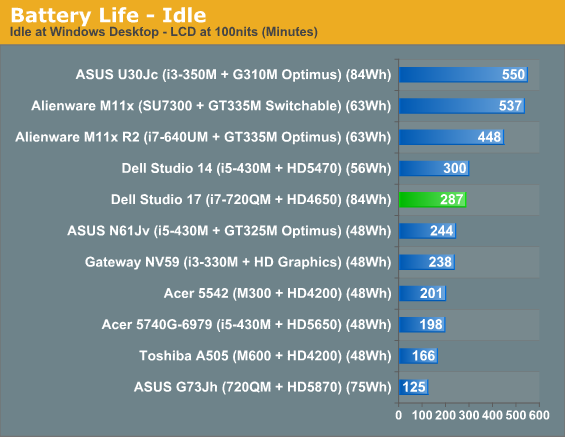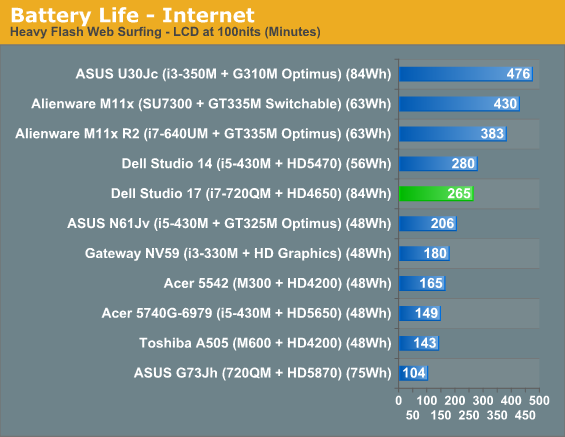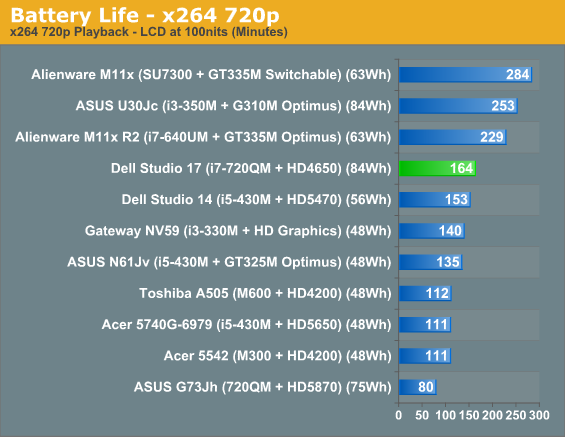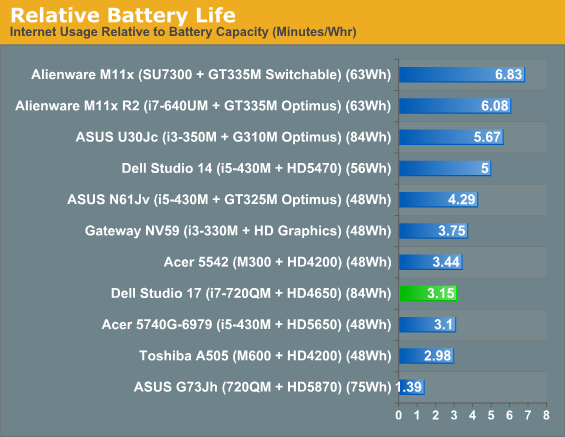Dell Studio 17: When Gaming Isn't Enough
by Dustin Sklavos on August 26, 2010 12:10 AM ESTBattery Life in a Desktop Replacement
If you aren't expecting much out of the battery of the Dell Studio 17, you're probably right not to. This is a massive 17-inch notebook; in addition to feeding that large screen, the battery also has to power a processor with a 45W TPD and mainstream-class mobile graphics. Dell seems to have been cognizant of this in opting to ship the Studio 17 with a 9-cell battery standard (a 6-cell battery that sits flush with the unit is also available.) Let's see how it fares.




In practice, Dell is able to get far more running time out of this notebook than we expected they would. While it's true that this notebook has the advantage of a 9-cell battery, its relative battery life is nonetheless quite good given the components inside and larger screen. Dell has managed to get a 17" screen, 45W Intel mobile quad-core, and a decent GPU to produce battery life comparable to AMD machines running off of integrated graphics: no mean feat to be sure. Granted, AMD's latest Danube and Nile platforms improve the situation, but Clarksfield processors have never been very battery friendly.
The only question mark is really just how important this kind of useful battery life is on a machine this big. Sure, it's great that it can handle surfing the internet for more than four hours, but the thing weighs nearly eight pounds, and it's mighty wide. The best case I can suggest is that it would be useful for any kind of on-the-go media work, where you need a monitor or just powerful hardware that can run on the battery for a substantial amount of time.










41 Comments
View All Comments
SteelCity1981 - Thursday, August 26, 2010 - link
Intel Core i7-720QM(4x1.6GHz, 45nm, 8MB L3, Turbo to 2.8GHz, 45W)
It should be....
Intel Core i7-720QM
(4x1.6GHz, 45nm, 6MB L3, Turbo to 2.8GHz, 45W)
The Intel Core i7-72xQM series use only 6MB of L3 cache.
JarredWalton - Thursday, August 26, 2010 - link
Fixed.InternetGeek - Thursday, August 26, 2010 - link
Hi Guys,I noticed the benchmarks do not include the HP Pavillion 17". Is it because it was too slow or just not available for the benchmarks?
Still reading the review...
JarredWalton - Thursday, August 26, 2010 - link
It's a case of reviewing what we've received... or in this case, what Dustin bought for himself. The reason he didn't even consider the Pavilion 17 is because he's a multimedia (video) user. He wanted quad-core i7, but he also needs Firewire support and would really like ExpressCard/34 as well. The Pavilion 17 lacks both features.kmmatney - Thursday, August 26, 2010 - link
I would love to get a new laptop, but my current Dell, which is over 3 years old, has a 17" 1920 x 1200 screen. Giving up those 300 vertical pixels is going to suck. I really wish they would go back to 16:10 screens, at least for laptops.I have to say my Dell Inspiron 9400, with a merom T7200, has been very good. It has taken a tremendous amount of travel and abuse (a 6 foot drop onto a concrete floor once) and has held up well. My next machine will be another Dell laptop, if I can help it, but I really hate the vertial screen resolutions.
B3an - Thursday, August 26, 2010 - link
If you read the display page you would have seen that you can choose a 1080p res display. Still less pixels but not many.I agree about 16:10, it's much better.
Nfarce - Thursday, August 26, 2010 - link
That's exactly what he's referring too (as I did below): 1920x1080 vs. 1920x1200.Oh and one other thing I forgot to mention for comparison's sake to the older Dell Inspirons of 2006-2007 E-series: even a 15" E1505 could be optioned with a 1920x1200 high resolution display.
Nfarce - Thursday, August 26, 2010 - link
I agree w/kmmatney. I also have a 17" Inspiron (E1705 that's 4 1/2 years old now with ATi x1300 and T7200). It ran the older games like HL2 and Return To Castle Wolfenstein great at 1920x1200. I still use it as a gaming machine for older games when I get the nostalgic feeling. But the days of 1920x1200 are drawing to a close even for regular LCDs, of which I have a 26" Samsung. Everything nowadays is at 1920x1080. Can anyone offer a logical explanation for that? I'm really bothered by this because I use Microsoft FSX a lot and 16x9 aspect resolution pinches the cockpit gauges somewhat.JarredWalton - Thursday, August 26, 2010 - link
Logical? Well, it's simply a case of the LCD panel makers being able to get more displays out of a sheet of glass substrate with 16:9 than with 16:10. If you do the math, of course, a 17" 16:10 panel is around 130 in^2 and a 17.3" 1080p panel is 128 in^2, but the glass sheets they're made from (with all the LCD circuitry and such) may be better sized for the wider+narrower panels.The other side of the equation is that with movies going widescreen, and the push for PCs to become more multimedia capable, WS displays make sense. That doesn't mean 16:9 is better than 16:10, but in some marketing departments....
erple2 - Thursday, August 26, 2010 - link
<quote>The other side of the equation is that with movies going widescreen, and the push for PCs to become more multimedia capable, WS displays make sense.</quote>Normally, I'd agree, but movies are generally far more than 16:9 AR. They're generally in the anamorphic (2.33:1) or 1.87:1 (not the 1.78:1, aka 16:9).
I think that your second guess (that the glass made for LCD panels lends itself better to 16:9) is probably the right one. I also suspect that became a circular "problem" - Someone somewhere decided to try 16:9 instead of 16:10, marketed that as the AR used for HD (720p or 1080p), then found out it was cheaper to make (for the same "size"), then stuck with it.